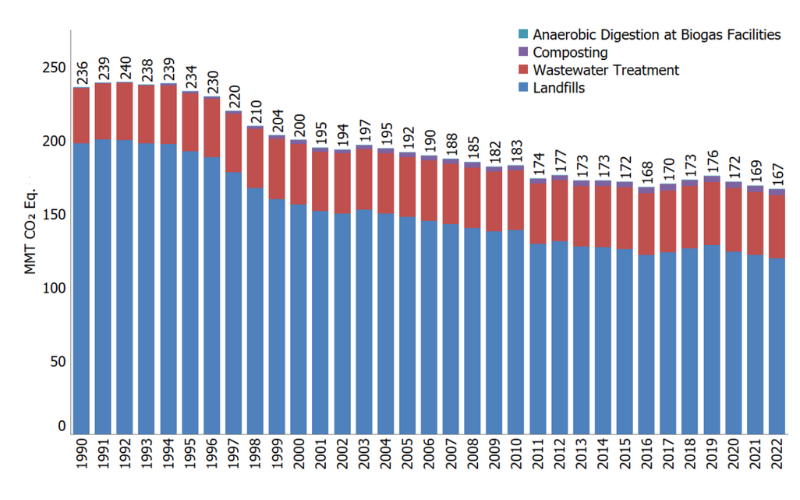Amidst record temperatures and rapid growth of manufacturing, there’s an increasing emphasis on addressing emissions. While emissions dominate environmental headlines, this attention is driving positive change with governments introducing and enhancing regulatory efforts.
The Environmental Protection Agency (EPA) reports that landfills are the third largest source of anthropogenic methane emissions in the United States and account for about 14.4% of total U.S. emissions.1 Landfills are a value-add to their communities and have the opportunity to enhance their perception by minimizing emissions and improving air quality. With a renewable natural gas (RNG) project, your landfill could significantly reduce methane emissions while making a positive impact by producing RNG that organizations can use to displace their use of fossil fuels.
Methane is one of the most potent greenhouse gases, and it has a serious impact on climate change: its warming potential is over 25 times greater than that of carbon dioxide over a 100-year period. Landfills generate methane emissions through anaerobic decomposition of organic waste, and methane emissions from the decomposing waste can pose health risks to nearby communities.
Emissions monitoring and reporting is becoming stricter too. With programs like the Greenhouse Gas Reporting Program (GHGRP) in place, landfills are required to accurately report their emissions, providing detailed data on the quantity released into the atmosphere. The Clean Air Act (CAA) sets national air quality standards and regulates emissions of pollutants, such as landfills. A non-profit group called Carbon Mapper flew over more than 200 landfills from 2018 to 2022 and found that average methane emissions were much higher than those officially reported in the EPA’s GHGRP: on average, methane emissions from these landfills were 1.4 times higher.2 The EPA is also leveraging drone technology like remote-sensing aircraft and high-resolution satellites to find methane leaks and hold those landfills accountable.3
An RNG project can play a significant role in reducing landfill methane emissions. Landfill biogas, which is comprised primarily of methane, goes through purification processes to be upgraded to RNG. By capturing the biogas, preventing it from escaping into the environment and upgrading it with an RNG project, this can lead to a decrease in a landfill’s emissions. The EPA reported that in 2022, landfills experienced their third consecutive year of decreasing emissions, which corresponded to an increase in natural gas generation and non-fossil fuel renewable energy generation.4
Trends in Waste Sector Greenhouse Gas Sources

The creation of RNG presents a unique opportunity for landfills to help corporations decrease their carbon footprint as well. Corporations can use the RNG produced by landfills instead of natural gas, which reduces their reliance on fossil fuels. Companies can use RNG to power their transportation fleets, which then reduces or even eliminates their need for diesel. The demand for RNG is growing; and with continued policy support and technology development, RNG is projected to grow to 3% of the North American natural gas market by 2050.5
Landfills with RNG projects are experiencing improved compliance with emissions requirements and a significant increase in yearly revenue through the sale of RNG. The benefits of an RNG project do not stop at the landfill; communities also benefit, as they can experience less odor issues and improved air quality while adding jobs to the local market.
Is your landfill ready to reduce its methane emissions? Working with us to install an RNG project will do exactly that, as we are committed to working with you to tailor a unique solution suited to your landfill’s needs. Whether your landfill is wanting to upgrade from an existing project to an RNG project or just starting the journey of creating renewable energy, our solutions streamline the process and ensure efficiency. The time to start is now: let’s guide your landfill to a more sustainable and profitable future with RNG.
1 Basic Information about Landfill Gas | US EPA, Inventory of U.S. Greenhouse Gas Emissions and Sinks: 1990-2022 – Waste (epa.gov)
2 Methane is seeping out of US landfills at rates higher than previously thought, scientists say | CNN
3 The EPA’s innovative new way of policing methane super emitters | Grist
4 Inventory of U.S. Greenhouse Gas Emissions and Sinks: 1990-2022 | US EPA
5 North American renewable natural gas market could expand tenfold by 2050 to reach 4 bcfd | Wood Mackenzie

